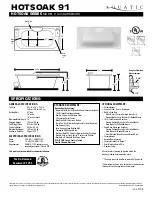
22
- When the CH is balanced, it normally remains sta-
ble, although adding soft water or very hard water
will raise or lower the CH level.
Balancing the pH
- The pH level is the measure of the balance
between acidity and alkalinity.
-
The recommended pH is 7.2 - 7.6.
- If the pH is too low, it can cause corrosion of
metal fixtures and the heating element.
- If the pH is too high, it can cause scaling by
allowing metals or minerals to form deposits and
stain spa surfaces.
Ozone
Ozone is a natural purifier. Chemically known as
O3, it is produced from simple oxygen molecules in
our atmosphere. Ozone is produced in nature from
lightning during electrical storms and from ultravio-
let rays from the sun. It forms our protective ozone
layer. Your spa’s ozone generator is designed to du-
plicate this natural sanitizer. Ozone breaks down
and oxidizes oils, suntan lotions, sweat, urea, etc.
from spa water more effectively than commercial
oxidizers. Ozone works with chlorine or bromine
systems in your spa to destroy bacteria and viruses
and will do so more effectively. Ozone only leaves
simple oxygen in the water as a by-product.
If your spa is equipped with an ozone generator it
will automatically produce ozone, but it cannot be
used as the sole means of maintaining safe spa
water. You must select and use a spa chemical
sani-tizer in addition to your ozone generator. The
ozone generator is a wearable, non-warranty item
and it needs to be replaced approximately every 2
years.
Too alkaline,
causes scaling
8.2
8.0
7.8
Ideal balance
7.6
7.4
7.2
Too acidic,
causes corrosion.
7.0
6.8
6.6
Decrease the
pH level.
Increase the
pH level.
Sanitation
You will need to decide which chemical sanitizer you
wish to use, regardless of the presence of an
ozonator. Spa owners with an ozonator still need to
use a chemical sanitizer. Sanitizers kill bacteria and
viruses and keep the water clean.
A low sanitizer level
will allow microbes to grow quickly in the spa water.
Use either bromine or chlorine as your sani-tizer or
a non-chlorine/non-bromine sanitizer.
All work well
when maintained regularly. Consult your spa dealer
for the right decision with regards to your lifestyle
and spa usage.
NOTE:
This manual will cover general chlorine
sanitation only.
If Using Chlorine as a Sanitizer
- Do not use Tri-chor tablets or liquid chlorine.
- Once a week, check the chlorine level using either
a test strip or a reagent kit. Refer to product for the
ideal range.
- Monitor chlorine levels of the spa water weekly.
Note that chlorine dissipation rate will be faster at
higher water temperatures and slower at lower
temperatures.
- When you add chlorine, make sure no bathers are
in the spa, open all jets and run the spa at high speed
with the cover open for at least 30 minutes.
If Using Bromine as a Sanitizer
- Bromine is a very effective sanitizer that produces
low chemical odors. Unlike chlorine, it can break
down bacteria and other impurities to a safe level
with a low burn-out rate.
Shocking the Water
- In addition to using a chemical sanitizer, you may
need to shock the water. Shocking the water helps
remove burned-out chemicals, bacteria, and other
organic material from your spa’s water and im-
proves your sanitizer’s effectiveness.
- Do not use chlorinating shock, which will damage
your spa’s jets and pump seals. Only use an oxidizer
shock. It is an easy way to maintain chemical plans.
- For best results use the directions below.
Add oxidizer shock:
- If sanitizer level temporarily reads low
- After heavy bather loads
- If water has a strong odor
Spa must be running with all of the jets on
high for 30 minutes with the cover open. If
necessary, repeat oxidizer shock in 30
minute intervals.
















































